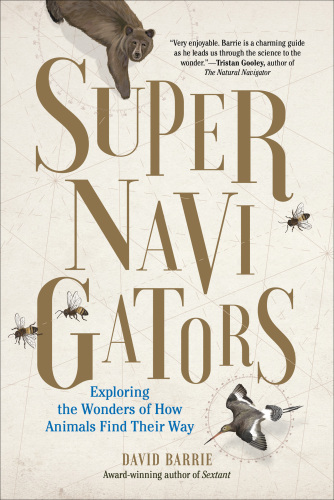
Supernavigators
Exploring the Wonders of How Animals Find Their Way
کتاب های مرتبط
- اطلاعات
- نقد و بررسی
- دیدگاه کاربران
نقد و بررسی

Starred review from March 18, 2019
Barrie (Sextant), a member of the Royal Institute of Navigation, masterfully conveys new discoveries about animal navigation in this impressive popular science work. In addition to the usual suspects, such as the Monarch butterfly, Barrie relates the achievements of more obscure creatures, including the desert ants of North Africa, which use the sun as a compass. He notes that insect brains, despite their tiny size, consistently “generate an impressively diverse repertoire of navigational behavior.” Even the lowly dung beetle is featured, as it is able to roll balls of dung in a straight line—backwards. Each chapter contains a surprise even for those familiar with the topic, such as the theory that homing pigeons make use of smell to navigate. Barrie cleverly stokes readers’ curiosity about the subject with short sections at the end of each chapter describing even more remarkable, still unexplained feats, such as two-inch-long dragonflies that fly at least 3,500 kilometers over the ocean without stopping. More generally, he expresses a wish that what’s been learned about the “neuroscience of navigation” in many species, including humans, might overcome anthropocentrism, driving home that “we are animals too.” This is a must-read for anyone fascinated with the wonders of nature. Agent: Catherine Clarke, Felicity Bryan Associates.

May 1, 2019
Whether dung beetles racing toward undisturbed dining spots or sea turtles returning to natal beaches, animals display impressive way-finding feats. Experimental research reveals that a variety of organisms can determine their location, plot or correct their course of travel, and even build and interpret internal maps. But as former transatlantic sailor Barrie (Sextant: A Young Man's Daring Sea Voyage and the Men Who Mapped the World's Oceans) notes, nonhuman species also use polarized light along with chemical (olfactory) and even magnetic cues that humans are unable to detect. Human disruption of the environment threatens animal navigation, and the author asserts that we should be better caretakers of our planet. This title is more suitable for casual science readers than James and Carol Gould's Nature's Compass: The Mystery of Animal Navigation, but with early chapters lacking a cohesive narrative, it is less literary than Bernd Heinrich's The Homing Instinct. VERDICT Readers interested in natural history or biology will find this stimulating.--Nancy R. Curtis, Univ. of Maine Lib., Orono
Copyright 2019 Library Journal, LLC Used with permission.

























دیدگاه کاربران